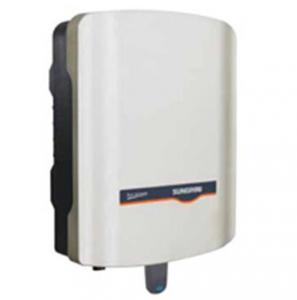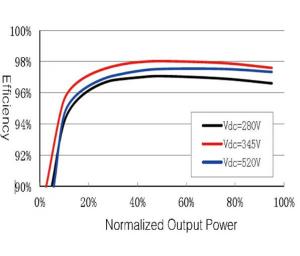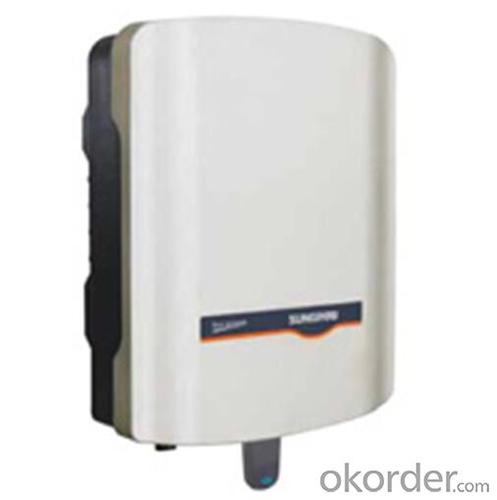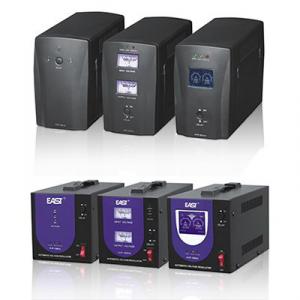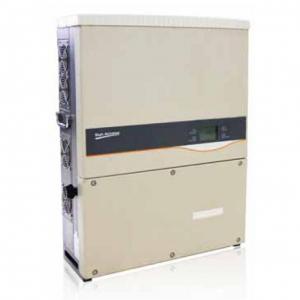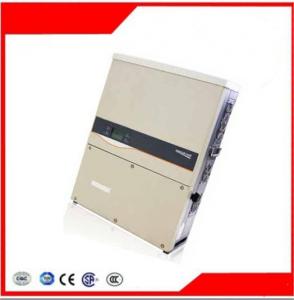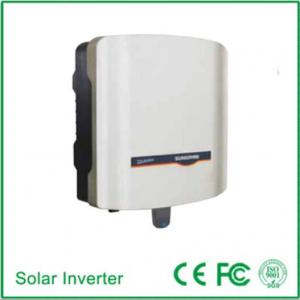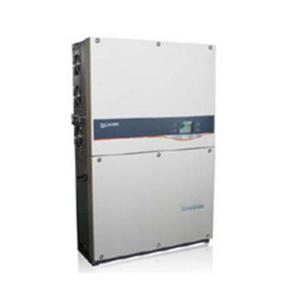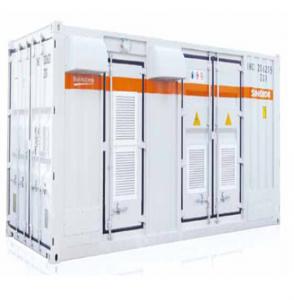300 Watt Solar Inverter SG5KTL-D Solar Photovoltaic Grid-Connected Inverter
- Loading Port:
- China Main Port
- Payment Terms:
- TT or LC
- Min Order Qty:
- 50000 unit
- Supply Capability:
- 3000000 unit/month
OKorder Service Pledge
OKorder Financial Service
You Might Also Like
1. Structure of Solar Photovoltaic Grid-Connected Inverter SG5KTL-D Description
A solar inverter, or PV inverter, or Solar converter, converts the variable direct current (DC) output of a photovoltaic (PV) solar panel into a
utility frequency alternating current (AC) that can be fed into a commercial electrical grid or used by a local, off-grid electrical network. It is a
critical BOS–component in a photovoltaic system, allowing the use of ordinary AC-powered equipment. Solar inverters have special
functions adapted for use with photovoltaic arrays, including maximum power point tracking and anti-islanding protection.
2. Main Features of the Solar Photovoltaic Grid-Connected Inverter SG5KTL-D
• Max. input voltage 600V, compatible with different PV panel and string design
• Dual MPPT, compatible with different residential rooftop system design
• Only 11kg, easy for handling and installation
• Max. Efficiency at 98.0%
• Ultra-quiet, suitable for residential use
• Access to home WiFi system, easy to enjoy the online monitoring
• Wireless communication design, intelligent mobile phone local and remote monitoring
• Product certification: TÜV, CE, AS4777, AS/NZS 3100, VDE AR N 4105
•Manufacturer certification: ISO 9001, ISO 14001, OHSAS 18000
3. Solar Photovoltaic Grid-Connected Inverter SG5KTL-D Images
4. Solar Photovoltaic Grid-Connected Inverter SG5KTL-D Specification
Input Side Data |
|
Max. PV input power | 5400W |
Max. PV input voltage | 600V |
Startup voltage | 150V |
Nominal input voltage | 345V |
MPP voltage range | 125~560V |
MPP voltage range for nominal power | 240~520V |
No. of MPPTs | 2 |
Max. number of PV strings per MPPT | 1 |
Max. PV input current | 22A(11A/11A) |
Max. current for input connector | 20A |
Output Side Data |
|
Nominal AC output power | 5000W / 4600W ( Australia )* |
Max AC output power(PF=1) | 5000W |
Max. AC output apparent power | 5000VA |
Max. AC output current | 21.7A / 20A ( Australia )* |
Nominal AC voltage | 230Vac (Single phase) |
AC voltage range | 180~276Vac (May vary as per corresponding country’s grid standard) |
Nominal grid frequency | 50Hz/60Hz |
Grid frequency range | 45~55Hz/55~65Hz (May vary as per corresponding country’s grid standard) |
THD | < 3 % (Nominal power) |
DC current injection | <0.5 %In |
Power factor | >0.99@default value at nominal power, (adj. 0.8 overexited~0.8 underexcited) |
Protection |
|
Anti-islanding protection | YES |
LVRT | NO |
DC reverse connection protection | YES |
AC short circuit protection | YES |
Leakage current protection | YES |
DC switch | Optional |
DC fuse | NO |
Overvoltage protection | Varistors |
System Data |
|
Max. efficiency | 98.00% |
Max. European efficiency | 97.50% |
Isolation method | Transformerless |
Ingress protection rating | IP65 |
Night power consumption | <1W |
Operating ambient temperature range | -25~60℃ (>45℃ derating) |
Allowable relative humidity range | 0~100% |
Cooling method | Natural cooling |
Max. operating altitude | 4000m (>2000m derating) |
Display | LED, LCD(optional) |
Communication | WiFi (optional) |
DC connection type | MC4 |
AC connection type | Plug and play connector |
Certification | IEC61000-6-2,IEC61000-6-3, |
Mechanical Data |
|
Dimensions(W×H×D) | 360*390*133 mm |
Mounting method | Wall bracket |
Weight | 11kg |
* When the SG5KTL-D type countries choose to Australia, rated output power is 4600W, when the SG5KTL-D type countries choose to Australia, the maximum output current is 20A.
* Specifications subject to change without notice.
5. FAQ of Solar Photovoltaic Grid-Connected Inverter SG5KTL-D
Q1. What is the difference between inverter and solar inverter?
A1. Inverter only has AC inpput, but solar inverter both connect to AC input and solar panel, it saves more power.
Q2. What is the difference between MPPT&PWM?
A2. MPPT has higher efficiency, it can track the max power point and won't waste energy.
- Q: Can a solar inverter be used with different types of grounding configurations?
- Yes, a solar inverter can be used with different types of grounding configurations. However, it is important to ensure that the grounding configuration of the inverter is compatible with the specific electrical system it is being connected to. It is recommended to consult the manufacturer's guidelines and local electrical codes to determine the appropriate grounding configuration for safe and efficient operation.
- Q: How does a solar inverter handle voltage regulation during load changes?
- A solar inverter handles voltage regulation during load changes by continuously monitoring the voltage and adjusting its output accordingly. It uses advanced control algorithms to regulate the voltage and ensure a stable and consistent supply of power to the connected load, even during fluctuations in demand. This allows the inverter to efficiently adapt to changing load conditions and maintain the desired voltage levels.
- Q: Can a solar inverter be used in a hybrid solar system?
- Yes, a solar inverter can be used in a hybrid solar system. A hybrid solar system combines both solar energy and another source of energy, such as a battery or grid power. The solar inverter is responsible for converting the DC (direct current) power generated by the solar panels into AC (alternating current) power that can be used to power the electrical devices in a home or business. In a hybrid solar system, the solar inverter can still perform this function, allowing the system to utilize solar energy while also being able to draw power from other sources when needed.
- Q: Can a solar inverter be repaired or does it need to be replaced?
- A solar inverter can be repaired in many cases, depending on the specific issue it is facing. However, there are instances where replacement may be necessary, especially if the inverter is old, damaged beyond repair, or if repairs would be more expensive than getting a new one. It is recommended to consult a professional to assess the situation and determine the most cost-effective solution.
- Q: How does a solar inverter convert DC to AC power?
- A solar inverter converts direct current (DC) power generated by solar panels into alternating current (AC) power that can be used in households and businesses. It does this through a two-step process. Firstly, the DC power from the solar panels is converted into a high-frequency AC power using power electronic switches, usually in the form of transistors. This high-frequency AC power is then transformed into a stable AC power with the desired voltage and frequency using transformers and filters. Overall, the solar inverter ensures that the DC power generated by the solar panels is converted into a usable AC power that can be fed into the electrical grid or consumed directly.
- Q: What is the role of a solar inverter in preventing underperformance?
- The role of a solar inverter in preventing underperformance is to convert the direct current (DC) electricity produced by the solar panels into alternating current (AC) electricity that can be used to power household appliances and be fed into the grid. The inverter also monitors the performance of the solar system, ensuring that it operates at maximum efficiency and identifying any issues or underperformance. By constantly optimizing the energy production and detecting any problems, the solar inverter plays a crucial role in preventing underperformance and maximizing the overall output of the solar power system.
- Q: Are there any ongoing maintenance requirements for a solar inverter?
- Yes, there are ongoing maintenance requirements for a solar inverter. Regular inspections, cleaning, and monitoring of the inverter's performance are necessary to ensure its optimal functioning. Additionally, checking for any loose connections, updating firmware, and addressing any potential issues promptly are part of the maintenance routine.
- Q: What is the role of a solar inverter in a grid-tied system?
- The role of a solar inverter in a grid-tied system is to convert the direct current (DC) electricity produced by the solar panels into alternating current (AC) electricity that can be used by the electrical grid or consumed by the appliances and devices in a home or business. It also ensures that the solar energy generated is synchronized with the grid's voltage and frequency to enable efficient and safe transfer of power. Additionally, the solar inverter monitors and controls the flow of electricity between the solar panels, the grid, and any energy storage systems that may be connected to the system.
- Q: What are the key factors affecting the reliability of a solar inverter?
- The key factors affecting the reliability of a solar inverter include the quality and durability of its components, such as the semiconductor devices, capacitors, and transformers. The design and manufacturing processes also play a significant role, as well as the overall system integration and installation. The environmental conditions, such as temperature, humidity, and dust levels, can impact the inverter's reliability, along with the quality of the electrical grid and the stability of the solar power generation. Regular maintenance and monitoring are crucial for identifying and addressing any potential issues that may arise, ensuring the long-term reliability of the solar inverter.
- Q: What is the role of fault ride-through capability in a solar inverter?
- The fault ride-through capability in a solar inverter is essential as it allows the inverter to remain connected to the grid during grid disturbances or faults. This capability ensures that the inverter can ride through and withstand voltage sags or dips in the grid, maintaining stability and continuous power generation. By providing this capability, the inverter helps to enhance grid reliability, prevent power disruptions, and contribute to the overall stability of the electrical system.
Send your message to us
300 Watt Solar Inverter SG5KTL-D Solar Photovoltaic Grid-Connected Inverter
- Loading Port:
- China Main Port
- Payment Terms:
- TT or LC
- Min Order Qty:
- 50000 unit
- Supply Capability:
- 3000000 unit/month
OKorder Service Pledge
OKorder Financial Service
Similar products
Hot products
Hot Searches
Related keywords
